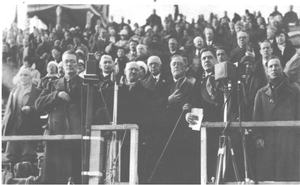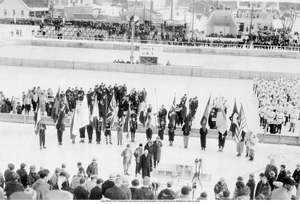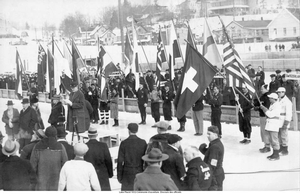 The Cooperation of Public and Private and the Meaning of "Forever Wild"
The Cooperation of Public and Private and the Meaning of "Forever Wild"
The effort to bring the III Winter Olympics to Lake Placid reflects a great triumph of cooperation among public and private interests in the Adirondack Park. Godfrey Dewey and the Lake Placid Olympic committee would not have been able to construct the necessary facilities to host the games had it not been for the Lake Placid Club, which, we should note, was not completely distinct from the organizing committee as Dewey was a member of both. Because efforts to build the bobsled run on public land were struck down as unconstitutional by the state courts, the contributions of the Club became vital to the feasibility of the project. The Club owned much of the land surrounding the town of Lake Placid and granted the organizers an easement to construct a sliding track on Mt. Van Hoevenberg. The Lake Placid Club also maintained a 60 meter ski jump on Intervales Hill that was made available for Olympic competition (Lattimer). In a more abstract sense, however, possibly the most important contribution of the the Lake Placid Club was its role in popularizing winter sports in the Park. The Club had maintained a ski jump on the site of the Olympic jump 10 years before the 1932 Olympics and it also built the first technically-engineered sliding track in the western hemisphere, although the first track’s utility was short-lived. Without the Club’s efforts to popularize skiing, ski jumping, and bobsledding in the Park, Lake Placid likely would not have placed a bid to host the games.
State and local governments also proved integral to the operation by funding many of the construction projects, offering the North Elba, NY High School as the base of operations for Olympic officials, and building and maintaining the ski trails that were used in the 18 and 50 km cross-country events. The Olympic Regional Development Authority, a division of the state government, now oversees the ski jump and sliding track from the 1932 games, as well as the ski facilities at Van Hoevenberg and Whiteface, which were not used until the 1980 Olympics.
But the broader impact of the 1932 Olympics was that it established precedent for a strict interpretation of the “forever wild” clause set forth in Article XII of the state constitution. In the years following the establishment of the Park and constitutional protection of the Forest Preserve, many sought to test the strictness of the “forever wild” clause. A few years before the the Olympics, a constitutional convention approved an Amendment to article XII that would permit the cutting of trees on the Forest Preserve in order to build a road to the summit of Mt. Whiteface. There was concern that this exception to the law would erode the binding status of Article XII and lead to many more exceptions, thus weakening the standard of protection of the Forest Preserve. The Appellate Division judge’s ruling marked a reversal of the trend of slackening legal standards of protection set by the Whiteface Highway. Although public lands in the Park can and should be used for recreation, the ruling justice wrote, the land must “always retain a character of wilderness.”
The entire history of the Park is, in a way, the history of the relationship of public and private interests. Today the Park contains over 6 million acres of land, just over half of which is privately held. The interconnectedness of minimally-protected private land adjacent to public land on which no tree may be cut that is unique to the region has made the cooperation of government and private landowners essential and unavoidable. This relationship is especially apparent in the context of the effort to construct the Van Hoevenberg bobsled run for the 1932 games.
The development of facilities for the Lake Placid Olympics is early example of the controversies surrounding land-use in the Park that continue today, as we have seen from debate about the Adirondack Club and Resort to be built in Tupper Lake and ongoing tension between landowners and the Adirondack Park Agency over acceptable uses of private land.


Lake Placid 1932-Opening Ceremony Opening Ceremony speeches
© Olympic.org © Olympic.org
